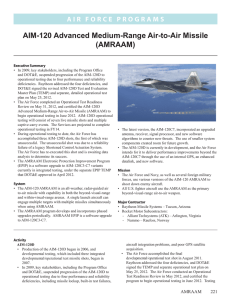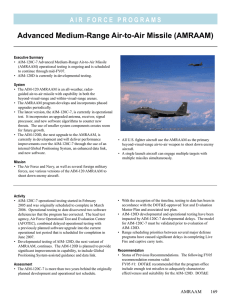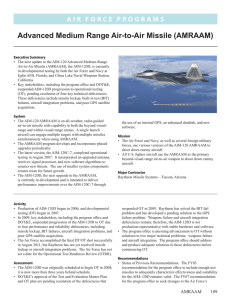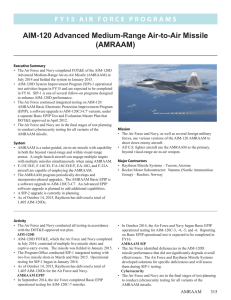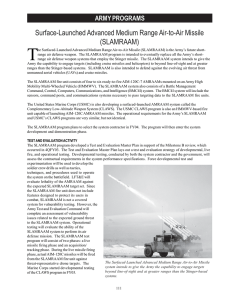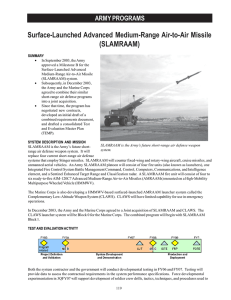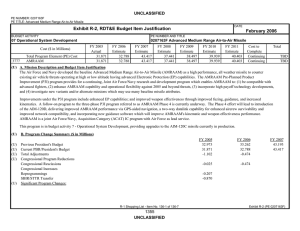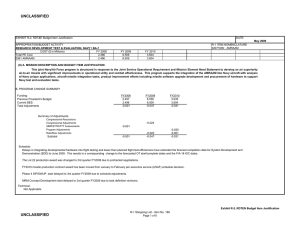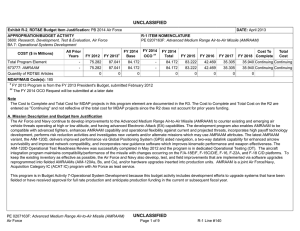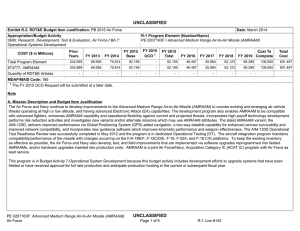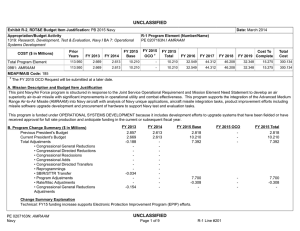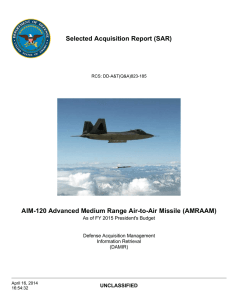AIM-120 Advanced Medium-Range Air-to-Air Missile (AMRAAM)
advertisement
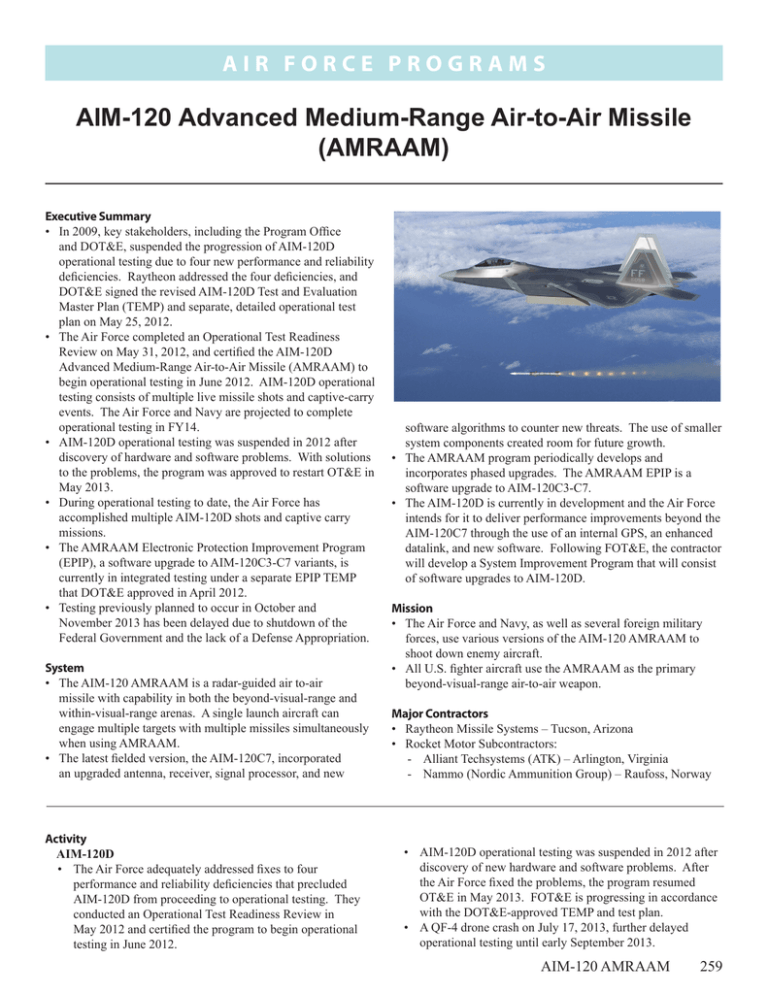
A i r F o r c e P RO G R A M S AIM-120 Advanced Medium-Range Air-to-Air Missile (AMRAAM) Executive Summary • In 2009, key stakeholders, including the Program Office and DOT&E, suspended the progression of AIM-120D operational testing due to four new performance and reliability deficiencies. Raytheon addressed the four deficiencies, and DOT&E signed the revised AIM-120D Test and Evaluation Master Plan (TEMP) and separate, detailed operational test plan on May 25, 2012. • The Air Force completed an Operational Test Readiness Review on May 31, 2012, and certified the AIM-120D Advanced Medium-Range Air-to-Air Missile (AMRAAM) to begin operational testing in June 2012. AIM-120D operational testing consists of multiple live missile shots and captive-carry events. The Air Force and Navy are projected to complete operational testing in FY14. • AIM-120D operational testing was suspended in 2012 after discovery of hardware and software problems. With solutions to the problems, the program was approved to restart OT&E in May 2013. • During operational testing to date, the Air Force has accomplished multiple AIM-120D shots and captive carry missions. • The AMRAAM Electronic Protection Improvement Program (EPIP), a software upgrade to AIM-120C3-C7 variants, is currently in integrated testing under a separate EPIP TEMP that DOT&E approved in April 2012. • Testing previously planned to occur in October and November 2013 has been delayed due to shutdown of the Federal Government and the lack of a Defense Appropriation. System • The AIM-120 AMRAAM is a radar-guided air to-air missile with capability in both the beyond-visual-range and within‑visual-range arenas. A single launch aircraft can engage multiple targets with multiple missiles simultaneously when using AMRAAM. • The latest fielded version, the AIM-120C7, incorporated an upgraded antenna, receiver, signal processor, and new Activity AIM-120D • The Air Force adequately addressed fixes to four performance and reliability deficiencies that precluded AIM-120D from proceeding to operational testing. They conducted an Operational Test Readiness Review in May 2012 and certified the program to begin operational testing in June 2012. software algorithms to counter new threats. The use of smaller system components created room for future growth. • The AMRAAM program periodically develops and incorporates phased upgrades. The AMRAAM EPIP is a software upgrade to AIM-120C3-C7. • The AIM-120D is currently in development and the Air Force intends for it to deliver performance improvements beyond the AIM-120C7 through the use of an internal GPS, an enhanced datalink, and new software. Following FOT&E, the contractor will develop a System Improvement Program that will consist of software upgrades to AIM-120D. Mission • The Air Force and Navy, as well as several foreign military forces, use various versions of the AIM-120 AMRAAM to shoot down enemy aircraft. • All U.S. fighter aircraft use the AMRAAM as the primary beyond-visual-range air-to-air weapon. Major Contractors • Raytheon Missile Systems – Tucson, Arizona • Rocket Motor Subcontractors: - Alliant Techsystems (ATK) – Arlington, Virginia - Nammo (Nordic Ammunition Group) – Raufoss, Norway • AIM-120D operational testing was suspended in 2012 after discovery of new hardware and software problems. After the Air Force fixed the problems, the program resumed OT&E in May 2013. FOT&E is progressing in accordance with the DOT&E-approved TEMP and test plan. • A QF-4 drone crash on July 17, 2013, further delayed operational testing until early September 2013. AIM-120 AMRAAM 259 A i r F o r c e P RO G R A M S • AIM-120D operational testing consists of multiple live missile shots and captive-carry events. The Services are projected to complete operational testing in FY14. • Testing previously planned to occur in October/ November 2013 has been delayed due to shutdown of the Federal Government and the lack of a Defense Appropriation. AMRAAM EPIP • DOT&E approved the AMRAAM EPIP TEMP on April 13, 2012, after which integrated testing began. Lot Acceptance Test (LAT)/Rocket Motors • Beginning in December 2011, rocket motor Lot Acceptance Test (LAT) performance became unpredictable at low temperatures (-65 degrees Fahrenheit) due to propellant hot spots and case burn-through failures. ATK, the subcontractor who produces the rocket motors, is developing a new propellant with projected availability in FY16. • The Program Office suspended performance-based payments to Raytheon and negotiated restructuring of the AMRAAM delivery schedule after delivery delays reached an unacceptable level. • The Program Office, Raytheon, and AMRAAM safety communities coordinated to certify Nammo to be an approved alternative rocket motor supplier. As of October 2013, Nammo had manufactured 1,000 motors in their role as the sole source provider for new production motors. • The Program Office has suspended performance-based payments to ATK until resolution of the shortage of rocket motors due to unacceptable LAT performance. 260 AIM-120 AMRAAM Assessment • The Air Force originally planned for AIM-120D to begin operational testing in 2008; it is now approximately four years behind schedule. • Since the start of operational testing, the Air Force has executed multiple live missile shots. Captive-carry performance has exceeded the interim Mean Time Between Failure requirement and is approaching the mature requirement of 450 hours. There are insufficient data to quantify free flight reliability with confidence. • The shortage in rocket motors due to unacceptable LAT performance should not significantly affect AIM-120D testing, but it has created a backlog in production. After Insensitive Munitions certification in October 2012, Nammo became the only AIM-120D and AIM-120C7 rocket motor producer for the foreseeable future. The government and Raytheon are still reviewing a path forward for ATK production. Recommendations • Status of Previous Recommendations. The Air Force satisfactorily addressed the previous recommendations. • FY13 Recommendation. 1. The Program Office should finalize and submit a test strategy and AIM-120D TEMP annex for DOT&E review and approval to ensure System Improvement Program 1 completion within one year after operational testing is completed.
